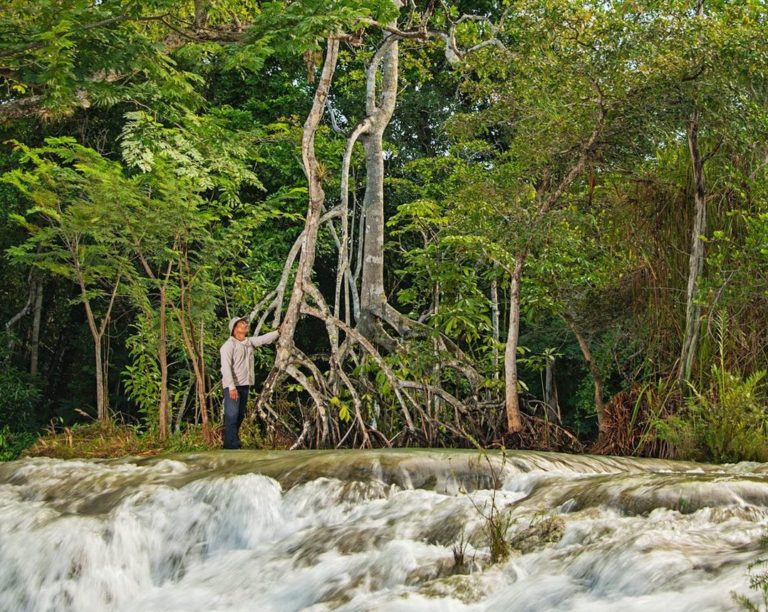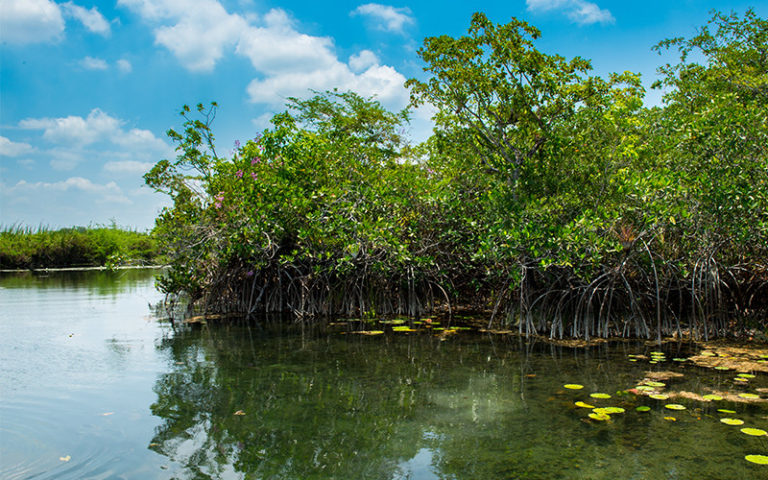A 100 000-year-old ‘coastal’ mangrove forest was found in Mexico, living around a freshwater lagoon. Genetics revealed that this forest proved to be living a relic of an ancient world, and could give insights into rising seas.

Octavio Aburto-Oropeza in the mangrove forest. Picture: Octavio Aburto-Oropeza/ @octavioaburto.
You probably asking yourself, how did a coastal mangrove forest emerge 160km inland? This is the same question Octavio Aburto-Oropeza of Scripps Institute of Oceanography and the lead author of the new study, was asking himself when he stumbled across these ancient mangroves.
Mangroves usually occur in intertidal zones, and although they can survive further inland, they struggle to compete with other plants. But over here, mangrove forests are thriving, standing tall amongst waterfalls and rapids.
And they are not alone, scattered around the lagoon are orchids, delicate ferns, sea grapes with ancient oyster shells lodged in sediments below, and along the edges of the lagoon.
Genetics revealed that this lagoon mangrove, located along San Pedro Martír River near the Mexico-Guatemala border, had been isolated from its closest relative 100 000 years ago, making them a ‘living relict of an ancient world,’ says Aburto-Oropeza
This timing aligns with when the Earths sea levels were much higher than today. The question of how much higher remains to be determined, but this is attributed to an astronomical phenomenon called ‘Earth wobbling.’
The earth wobbles?
Although a desktop globe always seems to rotate smoothly without any deviation, the real planet Earth wobbles. It’s nothing to worry about because it’s an astronomical phenomenon that occurs over a drawn-out period of 26 000 years, or 500 cm every 14 years.
Often referred to as the ‘Chandler Wobble,’ and is a small deviation in the Earths axis relative to solid earth. It’s a rather complicated phenomenon, which I’ll leave to NASA to explain. But it is relevant because it causes uncharacteristic weather events such as the ‘Great Frost’ of the 1700s in Europe.

Abraham Hondius’s painting A Frost Fair on the Thames River in London. The Thames Regularly froze over for long periods during the ‘Great Frost’ (c1684). Picture: Museum of London
It was predicted that 100 000 years ago, the world’s temperatures were similar to today’s and sea levels were significantly higher.
What’s this got to do with climate change?
Even though Earth wobbling does have an effect on the climate, it is an astronomical event that takes place over thousands of years. When scientists refer to climate change, they are referring to human-induced climate change since the industrial revolution, less than 300 years ago.
What these mangroves do tell us, however, is that temperatures 100 000 years ago were similar to today’s, and the lagoon’s mangroves were found at an altitude of more than 9 metres.
To put this into perspective, Alex Simms, a geologist at the University of California told National Geographic that ‘From the sea level standpoint, this and other work makes it clear that they have been much higher than today, even without us messing with the climate, so we should really be prepared for much higher sea levels.’
This could be a warning sign, where 770 million people live at elevations less than 5 metres above today’s sea level, a sea-level rise of 9 metres would be catastrophic.
This is all speculation, however, where the altitude of the mangroves could also be attributed to continental emergence. But Nicole Khan, a sea-level expert at Honk Kong University, argues that this research demonstrates that major sea-level changes are possible in conditions very similar to ours.
ALSO READ,
Scientists are trying to bring back the woolly mammoth from extinction
.



















